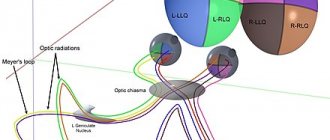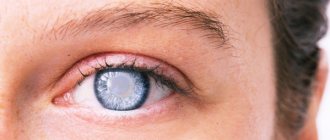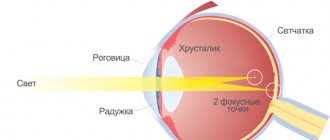How to properly guide your eyes through the text?
The less we move our eyes across the text, the better, because each time we move our eyes around the text takes away precious fractions of a second, or even a whole second, in just one movement. To do this, it is necessary to develop peripheral vision .
Training on online simulators
Schulte tables are specifically designed for this. The main thing is to look at the center of the table and look for the next number. It can be very difficult at first, so there are different modes: simple, easy - with the found numbers highlighted, and training - the simulator itself highlights the necessary numbers.
Try it now:
We have also developed another useful simulator for the development of peripheral or peripheral vision . When you click on the “Random phrase” button, the simulator displays a random sentence for 1-2 seconds. Try to look at the entire line:
Video training from the course: How to correctly complete Schulte Tables
Subscribe, and new useful exercises will always be at hand: VKontakteInstagramZenFacebookTelegramYoutube
Training on texts
Also try to use your peripheral vision (peripheral) when reading normally. At first you can take in, for example, 2 or 3 words, but then there will be more. And after some time you will be able to read entire lines, especially if they are small.
Also, some people have learned to read 2 or more lines at once or even entire paragraphs and pages. I was able to read in paragraphs and at one time even in short pages, but my eyes still moved across the page from top to bottom.
Now, for example, read this text line by line, looking strictly at the center of each line:
Just two words per line are easy to read and very fast. Interesting exercise. And the main thing is simple.
The text above is easy to read, the eyes do not move along the line, now let’s take a more difficult example (also read, looking strictly at the center of the line):
This text is more complex and also easy to read; the lines have become longer. The longer the line, the more difficult it is to read while looking at the center of the line. However, you are already training and making your first progress!
Still easy to read, but may be difficult. With a little practice it becomes easy.
Now try to read the same text, but a little wider (also read while looking strictly at the center of the line):
This text is more complex and also easy to read, although the lines have become longer. The longer the line, the more difficult it is to read while looking strictly at the center of the line. However, you are already training and making your first progress!
Yes, you already know this text and therefore it is easier for you to practice reading it, which is very good! Because this makes it easier for you to train your peripheral vision, try reading already known and completely new texts this way, alternate them, experiment!
Now read another text, from approximately the same long line:
This text is even more difficult than the previous one, but you are already a little trained, which helps you read this text with ease. This is exactly how you need to train, gradually, step by step, increasing the width of the line! Your skill just got better!
Most likely, even from such a small training you have already started the process, and reading such texts line by line has become easier!
Try reading the same text, only this time the line will be even longer (look strictly at the center of the line):
This text is even more difficult than the previous one, but you are already a little trained, which helps you read this text with ease. This is exactly how you need to train, gradually, step by step, increasing the width of the line! You are wonderful and your skill has become even better!
Thus, by increasing the line width you can develop excellent peripheral vision !
For this, it is very convenient to change the width of the browser window (if the site adapts to small mobile screens) or simply paste the text into a regular notepad on the computer, put in a font convenient for you, screen width and read.
Now try to completely take in this square with your gaze, looking at the very center of it:
Speed reading development course
Our Speed Reading course in 30 days will help you develop and synchronize both hemispheres of the brain. With synchronized, joint work of both hemispheres, the brain begins to work many times faster, which opens up much more possibilities.
The course contains a large number of exercises for training the brain, because with a fast reading speed you still need to have time to understand, remember and sometimes even think about information!
Sign up for a courseFree lesson
Disorders and diseases
The main task of peripheral vision is normal orientation in space. With retinal injuries, brain diseases, and other factors, peripheral vision is greatly affected. Only one eye or both may be affected at the same time.
Peripheral vision may be impaired in one eye or both.
Most often, problems with lateral vision arise against the background of various ophthalmological diseases. Among them:
- Glaucoma, accompanied by increased intraocular pressure and causing damage to the optic nerves. First, minor loss is noted in the periphery, then (in the absence of treatment) the field of view narrows, and irreversibly. In advanced stages, lateral vision atrophies completely.
- Mechanical damage to the retina - occurs as a result of sudden changes in pressure, stress, heavy loads, certain diseases, and head injuries. Retinal defects lead to damage to the optic nerve, which already has a corresponding effect on the viewing angle.
- Poor blood circulation in the optic nerves or brain.
- Formations of benign and malignant nature.
- Traumatic brain injuries.
- Degenerative processes in the retina.
Peripheral vision often suffers after strokes. This problem most often occurs in people aged 60 years and older.
Online simulators for the development of peripheral vision
Especially for the development of peripheral vision, we have developed a special simulator that shows random phrases. Try to look at the entire line:
Search for numbers and numbers
Try also to practice finding numbers and figures. This exercise is great for developing peripheral vision and speed reading. You can read more about this exercise in a separate article Finding numbers and numbers.
Letter search
It is also useful to practice the same exercise not with letters, especially if the eye is already accustomed to numbers. You can read more about this exercise in a separate article Searching for letters.
Schulte tables
Schulte tables are specifically designed for this. The main thing is to look at the center of the table and look for the next number. It can be very difficult at first, so there are different modes: simple, easy - with the found numbers highlighted, and training - the simulator itself highlights the necessary numbers.
Try it now:
Gorbov-Schulte tables
Schulte-Gorbov tables are complicated Schulte tables, which are also called red-black Schulte tables. They are no less effective than regular Schulte tables, so it is very important to work with Gorbov-Schulte tables. You need to first find the minimum black number, then the maximum red number, then again the minimum black number, after that again the maximum red number, and so on. The simulator itself will tell you what you need to find:
Games for developing peripheral vision
Below are some interesting brain development games as an example. In order for not only the brain to develop during the game, but also peripheral vision, we recommend looking strictly at the center of the playing field!
Game "Memory Matrix"
- Develops memory capacity
- Improves visual memory
- Improves spatial memory
Immediately after the start, a field with several filled cells will appear on the screen. In 3 seconds you need to remember which cells are colored and click on them when the field is cleared. With almost every successful round, the field expands. The more cells you need to remember, the more efficiently your memory develops and the more points you earn. The first results will be available after 10 minutes of play.
Play now
Game "Visual Geometry"
“Visual Geometry” - an exercise that will help speed up your train of thought and increase memorability and memory. With each level the game becomes more difficult. A great game for brain development . How many levels can you complete?
Play now
Game "Mathematical Comparisons"
I present a wonderful game “Mathematical Comparisons”, with which you can relax your body and tense your brain. The screenshot shows an example of this game, in which there will be a question related to the picture, and you will need to answer. Time is limited. How much time will you have to answer?
Play now
Game "Find a Pair"
In this game you will need skills such as the ability to search for the necessary objects among others, speed of thought, reaction, comparison skill, search skill. And the game, in turn, will help develop these skills to a higher level. An excellent game for brain development , like all other exercises from this site. Register and grow with us!
Play now
Game "Guess the operation"
This is one of the best brain training exercises because you will need to insert the math symbols correctly to get the correct result. The presented exercise will help you develop mental arithmetic, logic and speed of thought. With almost every correct answer, the difficulty increases.
Play now
Game "Piggy Bank"
I can’t resist recommending to you the game “Piggy Bank” from the same site where you need to register, indicating only your E-mail and password. This game can provide you with excellent fitness for your brain and relaxation for your body. The essence of the game is to indicate 1 of 4 windows in which the amount of coins is the largest. Will you be able to show excellent results? We are waiting for you!
Play now
Central vision
Historically, men have always been the breadwinner. In ancient times, they hunted a lot, so they had to focus on one target often and for a long time. In this case, central vision was involved. As a result of human evolution, the brain began to provide so-called tunnel vision. This term means that only one object is in the field of view, while everything else is blurred. Thanks to this, we are able to quickly respond to any changes and take timely measures. Thus, we can draw an analogy of central vision with binoculars. Their operating principle is very similar.
The right choice: the 5 most delicious varieties of apples sold on the market have been identified
The Internet made fun of: a husky tried to wake up a domestic pig for a long time (video)
Two types of sugar and a little patience. Delicious cookies for milk
As for peripheral vision, men simply did not use it, so it did not develop. Undoubtedly, they also have it, but it does not function as well as the central one. This is quite normal and is not considered any abnormality. The fault lies with the genetics laid down by our distant ancestors.











